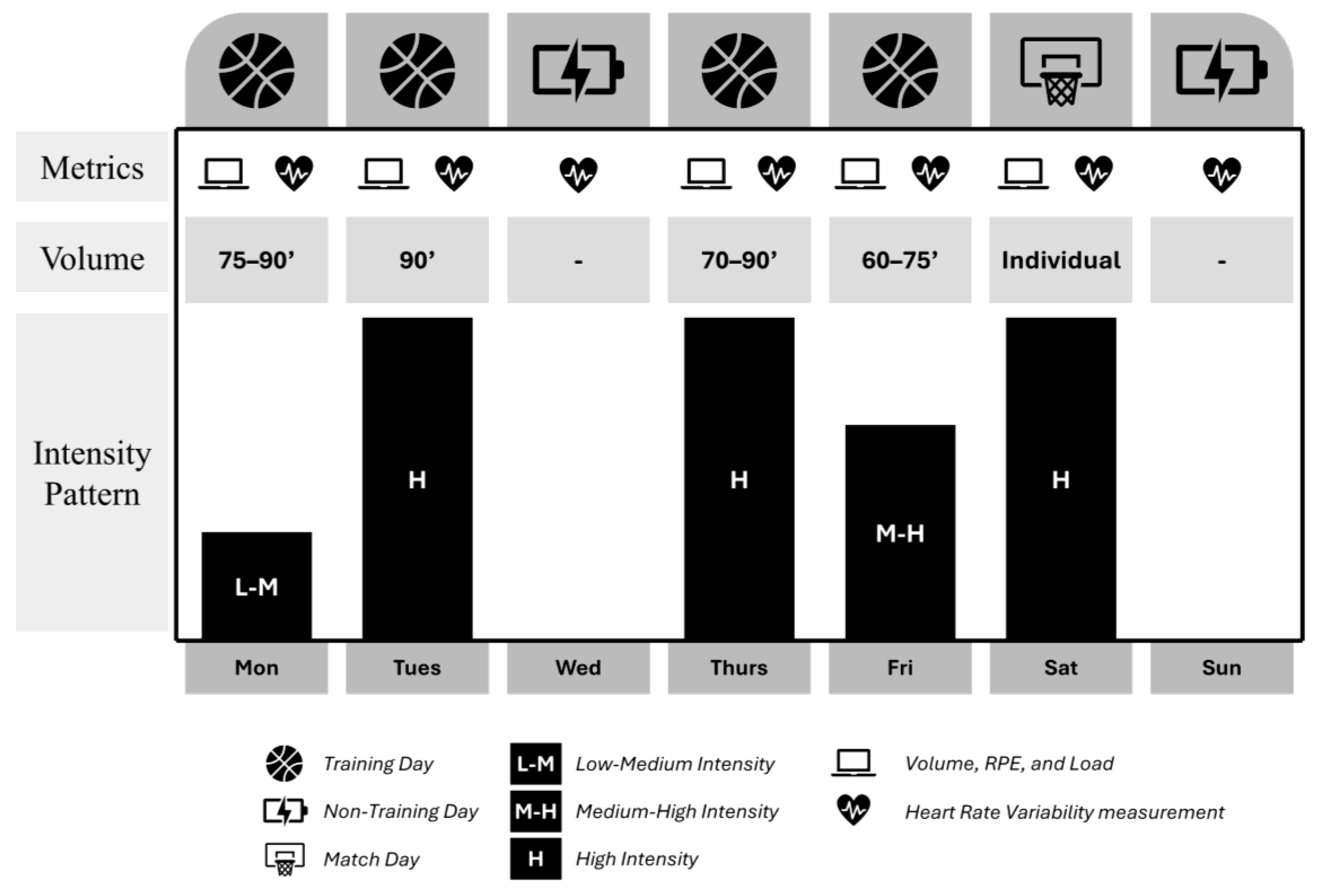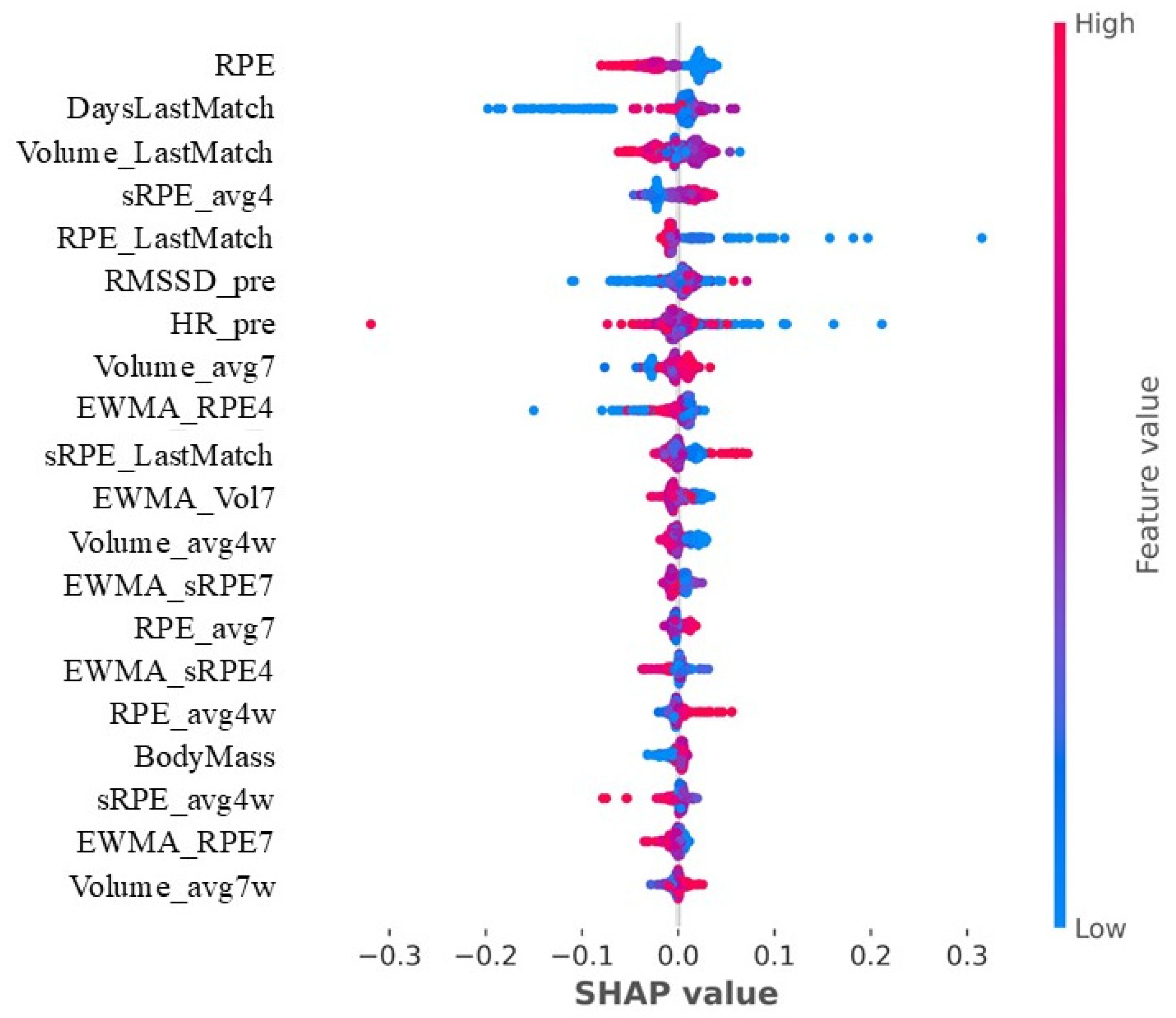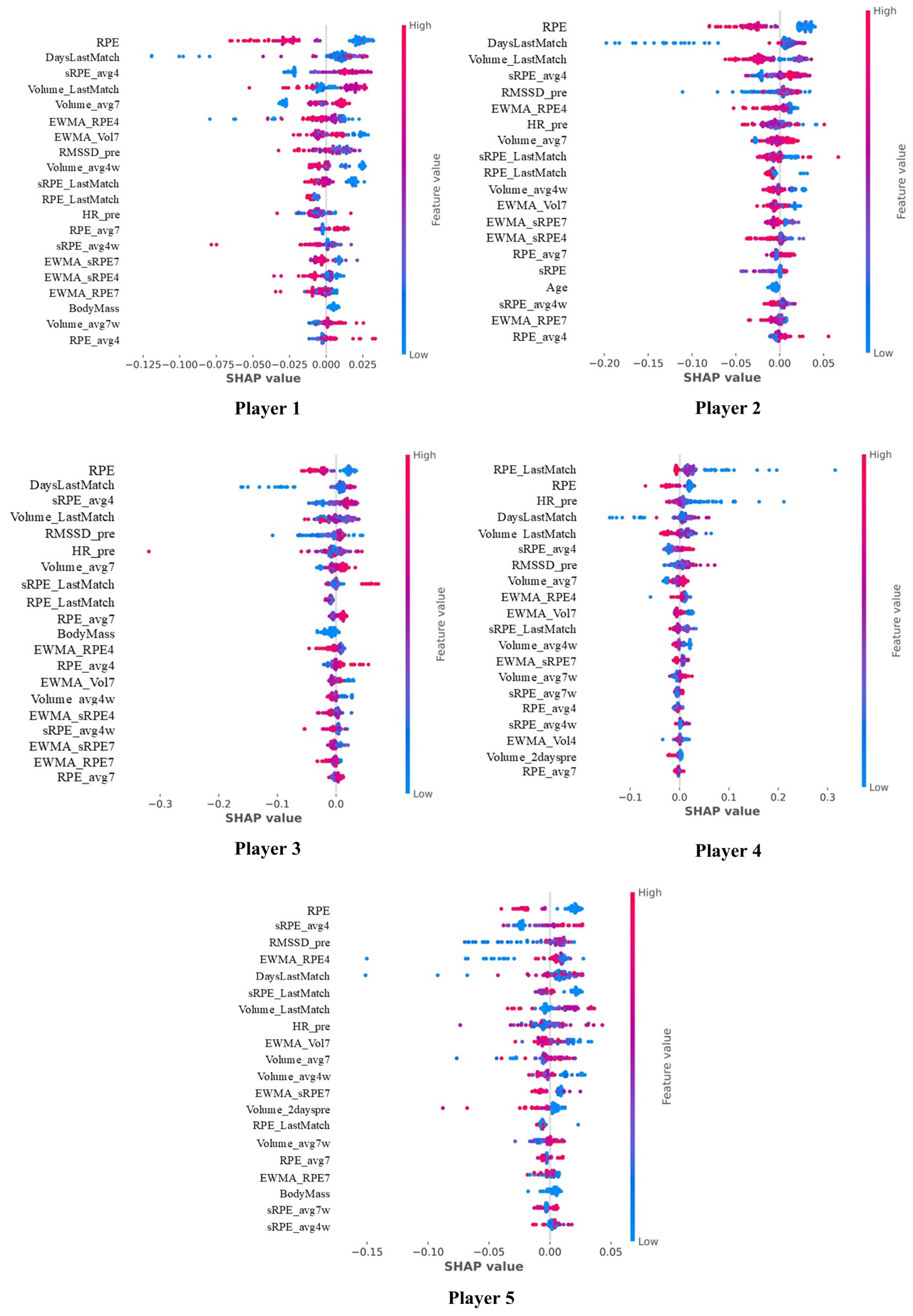An Explainable Machine Learning Approach to Explain the Effects of Training and Match Load on Ultra-Short-Term Heart Rate Variability in Semi-Professional Basketball Players
Highlights
- Heart rate variability showed sensitivity to different measures of training and match load across the season.
- An individualized, explanatory modeling approach helped to identify which load variables influenced the internal response and in what direction.
- Monitoring heart rate variability alongside training load can inform athlete management strategies in team sports.
- The methodological framework highlights how individualized, explainable analyses can refine the dose–response process, even if further validation is needed in other contexts.
Abstract
1. Introduction
2. Materials and Methods
2.1. Study Design
2.2. Participants
2.3. Procedures
2.3.1. Training Days Classification (MD-TD-NTD)
2.3.2. Training Load
2.3.3. Heart Rate Variability
2.4. Statistical Analyses
3. Results
4. Discussion
5. Conclusions
Supplementary Materials
Author Contributions
Funding
Institutional Review Board Statement
Informed Consent Statement
Data Availability Statement
Conflicts of Interest
Abbreviations
| EWMA | Exponentially Weighted Moving Average |
| HR | Heart Rate |
| HRV | Heart Rate Variability |
| LnRMSSD | Natural Logarithm of the Root Mean Square of Successive Differences |
| MD | Match Day |
| NTD | Non-Training Day |
| PPG | Photoplethysmograph |
| RMSE | Root Mean Squared Error |
| RMSSD | Root Mean Square of Successive Differences |
| RPE | Rate of Perceived Exertion |
| SHAP | SHapley Additive exPlanation |
| sRPE | Session Rate of Perceived Exertion |
| TD | Training Day |
| XGBoost | Extreme Gradient Boosting |
Appendix A
| Name | Definition |
|---|---|
| Height | Height in centimeters. |
| Age | Age at the start of the season |
| BodyMass | Body mass in kilograms |
| MD-TD-NTD | Classification of days based on whether it was a match day (MD), training day (TD), or non-training/non-match day (NTD). |
| Volume | Volume in minutes of session duration in the case of training days. For matches, the number of minutes played in the game. |
| Volume_2dayspre | Volume metric (in minutes) from the two days prior to the HRV measurement (as HRV is measured the morning following the stimulus). |
| Volume_avg4 | Mean volume (in minutes) over the last 4 days |
| Volume_avg7 | Mean volume (in minutes) over the last 7 days |
| Volume_avg4w | Weighted average of the volume over the last 4 days, with a weight of 4 for the most recent day, 3 for the following day, 2 for the next, and 1 for the day furthest back. |
| Volume_avg7w | Weighted average of the volume over the last 7 days, with a weight of 7 for the most recent day and decreasing by one each day until assigning a weight of 1 to the day furthest back. |
| Volume_LastMatch | Minutes played in the last match |
| EWMA | Exponentially Weighted Moving Average Method for monitoring load through the acute-to-chronic ratio, which assigns a decreasing weight to each older load value, thereby giving greater weight to recent load. EWMA = Metric × λ + ((1 − λ) × (EWMAyesterday)), Where Metric refers to the observed value in the load metric (RPE, Volume, etc.), Lambda represents a constant between 0 and 1 that determines the depth of how many days influence the calculation. Assigning a lower value means that older values retain significant weight for a longer period. EWMA yesterday refers to the EWMA value for the previous day. |
| EWMA_RPE4 | EWMA of the RPE variable where lambda equals 4 |
| EWMA_RPE7 | EWMA of the RPE variable where lambda equals 7 |
| EWMA_sRPE4 | EWMA of the sRPE variable where lambda equals 4 |
| EWMA_sRPE7 | EWMA of the sRPE variable where lambda equals 7 |
| EWMA_Vol4 | EWMA of the Volume variable where lambda equals 4 |
| EWMA_Vol7 | EWMA of the Volume variable where lambda equals 7 |
| HR | Heart rate (in beats per minute) on the day following to the stimulus. |
| HR_pre | Early morning heart rate (in beats per minute) on the same day as the training or match. |
| RMSSD | Calculating each successive time difference between heartbeats in milliseconds. Then, each of the values is squared and the result is averaged before the square root of the total is obtained. |
| RMSSD_pre | Early morning RMSSD in milliseconds on the same day as the training or match. |
| LnRMSSD | A natural log is applied to the RMSSD to smooth the data and facilitate interpretation. |
| RPE | Subjective rating of session intensity was assessed using Borg’s 1–10 scale, in response to the question, ‘How intense did the session feel?’ |
| RPE_2days | RPE metric from the two days prior to the HRV measurement (as HRV is measured the morning following the stimulus). |
| RPE_avg4 | Mean RPE over the last 4 days |
| RPE_avg7 | Mean RPE over the last 7 days |
| RPE_avg4w | Weighted average of the RPE over the last 4 days, with a weight of 4 for the most recent day, 3 for the following day, 2 for the next, and 1 for the day furthest back. |
| RPE_avg7w | Weighted average of the RPE over the last 7 days, with a weight of 7 for the most recent day and decreasing by one each day until assigning a weight of 1 to the day furthest back. |
| RPE_LastMatch | RPE reported in the last match |
| sRPE | Result of multiplying the session volume in minutes by the RPE. |
| sRPE_2days | sRPE from two days prior (as HRV is measured the morning following the stimulus) |
| sRPE_avg4 | Mean sRPE over the last 4 days |
| sRPE_avg7 | Mean sRPE over the last 7 days |
| sRPE_avg4w | Weighted average of the sRPE over the last 4 days, with a weight of 4 for the most recent day, 3 for the following day, 2 for the next, and 1 for the day furthest back. |
| sRPE_avg7w | Weighted average of the sRPE over the last 7 days, with a weight of 7 for the most recent day and decreasing by one each day until assigning a weight of 1 to the day furthest back. |
| sRPE_LastMatch | Result of multiplying the minutes played in the last match by the RPE. |
| DaysLastMatch | Number of days since the player’s last match. |
References
- Griffin, A.; Kenny, I.C.; Comyns, T.M.; Lyons, M. The Association Between the Acute:Chronic Workload Ratio and Injury and its Application in Team Sports: A Systematic Review. Sports Med. 2020, 50, 561–580. [Google Scholar] [CrossRef]
- Impellizzeri, F.M.; Marcora, S.M.; Coutts, A.J. Internal and External Training Load: 15 Years on. Int. J. Sports Physiol. Perform. 2019, 14, 270–273. [Google Scholar] [CrossRef]
- Piedra, A.; Peña, J.; Caparrós, A. Monitoring Training Loads in Basketball: A Narrative Review and Practical Guide for Coaches and Practitioners. Strength Cond. J. 2021, 43, 12–35. [Google Scholar] [CrossRef]
- McLaren, S.J.; Macpherson, T.W.; Coutts, A.J.; Hurst, C.; Spears, I.R.; Weston, M. The Relationships Between Internal and External Measures of Training Load and Intensity in Team Sports: A Meta-Analysis. Sports Med. 2018, 48, 641–658. [Google Scholar] [CrossRef]
- Vanrenterghem, J.; Nedergaard, N.J.; Robinson, M.A.; Drust, B. Training Load Monitoring in Team Sports: A Novel Framework Separating Physiological and Biomechanical Load-Adaptation Pathways. Sports Med. 2017, 47, 2135–2142. [Google Scholar] [CrossRef]
- Montgomery, P.G.; Pyne, D.B.; Minahan, C.L. The physical and physiological demands of basketball training and competition. Int. J. Sports Physiol. Perform. 2010, 5, 75–86. [Google Scholar] [CrossRef] [PubMed]
- Torres-Ronda, L.; Ric, A.; Llabres-Torres, I.; de Las Heras, B.; Schelling IDel Alcazar, X. Position-Dependent Cardiovascular Response and Time-Motion Analysis During Training Drills and Friendly Matches in Elite Male Basketball Players. J. Strength Cond. Res. 2016, 30, 60–70. [Google Scholar] [CrossRef]
- Fox, J.L.; Scanlan, A.T.; Stanton, R. A Review of Player Monitoring Approaches in Basketball: Current Trends and Future Directions. J. Strength Cond. Res. 2017, 31, 2021–2029. [Google Scholar] [CrossRef]
- Buchheit, M. Monitoring training status with HR measures: Do all roads lead to Rome? Front. Physiol. 2014, 5, 73. [Google Scholar] [CrossRef] [PubMed]
- Schneider, C.; Hanakam, F.; Wiewelhove, T.; Döweling, A.; Kellmann, M.; Meyer, T.; Pfeiffer, M.; Ferrauti, A. Heart Rate Monitoring in Team Sports—A Conceptual Framework for Contextualizing Heart Rate Measures for Training and Recovery Prescription. Front. Physiol. 2018, 9, 639. [Google Scholar] [CrossRef] [PubMed]
- Flatt, A.A.; Esco, M.R.; Nakamura, F.Y.; Plews, D.J. Interpreting daily heart rate variability changes in collegiate female soccer players. J. Sports Med. Phys. Fit. 2017, 57, 907–915. [Google Scholar] [CrossRef] [PubMed]
- Flatt, A.A.; Esco, M.R.; Nakamura, F.Y. Individual Heart Rate Variability Responses to Preseason Training in High Level Female Soccer Players. J. Strength Cond. Res. 2017, 31, 531–538. [Google Scholar] [CrossRef]
- Kiviniemi, A.M.; Hautala, A.J.; Kinnunen, H.; Tulppo, M.P. Endurance training guided individually by daily heart rate variability measurements. Eur. J. Appl. Physiol. 2007, 101, 743–751. [Google Scholar] [CrossRef]
- McCraty, R.; Shaffer, F. Heart Rate Variability: New Perspectives on Physiological Mechanisms, Assessment of Self-regulatory Capacity, and Health risk. Glob. Adv. Health Med. 2015, 4, 46–61. [Google Scholar] [CrossRef] [PubMed]
- Stanley, J.; Peake, J.M.; Buchheit, M. Cardiac parasympathetic reactivation following exercise: Implications for training prescription. Sports Med. 2013, 43, 1259–1277. [Google Scholar] [CrossRef]
- Flatt, A.A.; Allen, J.R.; Keith, C.M.; Martinez, M.W.; Esco, M.R. Season-Long Heart-Rate Variability Tracking Reveals Autonomic Imbalance in American College Football Players. Int. J. Sports Physiol. Perform. 2021, 16, 1834–1843. [Google Scholar] [CrossRef]
- Plews, D.J.; Laursen, P.B.; Buchheit, M. Day-to-Day Heart-Rate Variability Recordings in World-Champion Rowers: Appreciating Unique Athlete Characteristics. Int. J. Sports Physiol. Perform. 2017, 12, 697–703. [Google Scholar] [CrossRef]
- Nakamura, F.Y.; Pereira, L.A.; Rabelo, F.N.; Flatt, A.A.; Esco, M.R.; Bertollo, M.; Loturco, I. Monitoring weekly heart rate variability in futsal players during the preseason: The importance of maintaining high vagal activity. J. Sports Sci. 2016, 34, 2262–2268. [Google Scholar] [CrossRef] [PubMed]
- O’Connor, F.K.; Doering, T.M.; Chapman, N.D.; Ritchie, D.M.; Bartlett, J.D. A two-year examination of the relation between internal and external load and heart rate variability in Australian Rules Football. J. Sports Sci. 2024, 42, 1400–1409. [Google Scholar] [CrossRef]
- Flatt, A.A.; Howells, D. Effects of varying training load on heart rate variability and running performance among an Olympic rugby sevens team. J. Sci. Med. Sport 2019, 22, 222–226. [Google Scholar] [CrossRef]
- Sekiguchi, Y.; Huggins, R.A.; Curtis, R.M.; Benjamin, C.L.; Adams, W.M.; Looney, D.P.; West, C.A.; Casa, D.J. Relationship Between Heart Rate Variability and Acute:Chronic Load Ratio Throughout a Season in NCAA D1 Men’s Soccer Players. J Strength Cond. Res. 2021, 35, 1103–1109. [Google Scholar] [CrossRef]
- Scanlan, A.T.; Wen, N.; Tucker, P.S.; Dalbo, V.J. The relationships between internal and external training load models during basketball training. J. Strength Cond. Res. 2014, 28, 2397–2405. [Google Scholar] [CrossRef]
- Rossi, A.; Pappalardo, L.; Cintia, P. A Narrative Review for a Machine Learning Application in Sports: An Example Based on Injury Forecasting in Soccer. Sports 2021, 10, 5. [Google Scholar] [CrossRef] [PubMed]
- Winter, E.M.; Maughan, R.J. Requirements for ethics approvals. J. Sports Sci. 2009, 27, 985. [Google Scholar] [CrossRef] [PubMed]
- Kellmann, M.; Bertollo, M.; Bosquet, L.; Brink, M.; Coutts, A.J.; Duffield, R.; Erlacher, D.; Halson, S.L.; Hecksteden, A.; Heidari, J.; et al. Recovery and Performance in Sport: Consensus Statement. Int. J. Sports Physiol. Perform. 2018, 13, 240–245. [Google Scholar] [CrossRef] [PubMed]
- Williams, S.; West, S.; Cross, M.J.; Stokes, K.A. Better way to determine the acute:chronic workload ratio? Br. J. Sports Med. 2017, 51, 209–210. [Google Scholar] [CrossRef]
- Murray, N.B.; Gabbett, T.J.; Townshend, A.D.; Blanch, P. Calculating acute:chronic workload ratios using exponentially weighted moving averages provides a more sensitive indicator of injury likelihood than rolling averages. Br. J. Sports Med. 2017, 51, 749–754. [Google Scholar] [CrossRef]
- Plews, D.J.; Scott, B.; Altini, M.; Wood, M.; Kilding, A.E.; Laursen, P.B. Comparison of Heart-Rate-Variability Recording With Smartphone Photoplethysmography, Polar H7 Chest Strap, and Electrocardiography. Int. J. Sports Physiol. Perform. 2017, 12, 1324–1328. [Google Scholar] [CrossRef]
- Nakamura, F.Y.; Flatt, A.A.; Pereira, L.A.; Ramirez-Campillo, R.; Loturco, I.; Esco, M.R. Ultra-Short-Term Heart Rate Variability is Sensitive to Training Effects in Team Sports Players. J. Sports Sci. Med. 2015, 14, 602–605. [Google Scholar]
- Altini, M.; Plews, D. What Is behind Changes in Resting Heart Rate and Heart Rate Variability? A Large-Scale Analysis of Longitudinal Measurements Acquired in Free-Living. Sensors 2021, 21, 7932. [Google Scholar] [CrossRef]
- Esco, M.R.; Flatt, A.A. Ultra-Short-Term Heart Rate Variability Is Sensitive to Training Effects in Team Sport Athletes. J. Sports Sci. Med. 2014, 13, 535–542. [Google Scholar] [CrossRef] [PubMed]
- Nakamura, F.Y.; Torres, V.B.C.; da Silva, L.S.; Gantois, P.; Andrade, A.D.; Ribeiro, A.L.B.; Brasileiro-Santos, M.D.S.; Batista, G.R. Monitoring Heart Rate Variability and Perceived Well-Being in Brazilian Elite Beach Volleyball Players: A Single-Tournament Pilot Study. J. Strength Cond. Res. 2022, 36, 1708–1714. [Google Scholar] [CrossRef] [PubMed]
- Sartor, F.; Vailati, E.; Valsecchi, V.; Vailati, F.; La Torre, A. Heart rate variability reflects training load and psychophysiological status in young elite gymnasts. J. Strength Cond. Res. 2013, 27, 2782–2790. [Google Scholar] [CrossRef]
- Kim, H.G.; Cheon, E.J.; Bai, D.S.; Lee, Y.H.; Koo, B.H. Stress and Heart Rate Variability: A Meta-Analysis and Review of the Literature. Psychiatry Investig. 2018, 15, 235–245. [Google Scholar] [CrossRef]
- Halson, S.L. Monitoring training load to understand fatigue in athletes. Sports Med. 2014, 44 (Suppl. S2), 139–147. [Google Scholar] [CrossRef] [PubMed]





Disclaimer/Publisher’s Note: The statements, opinions and data contained in all publications are solely those of the individual author(s) and contributor(s) and not of MDPI and/or the editor(s). MDPI and/or the editor(s) disclaim responsibility for any injury to people or property resulting from any ideas, methods, instructions or products referred to in the content. |
© 2025 by the authors. Licensee MDPI, Basel, Switzerland. This article is an open access article distributed under the terms and conditions of the Creative Commons Attribution (CC BY) license (https://creativecommons.org/licenses/by/4.0/).
Share and Cite
Abruñedo-Lombardero, J.; Padrón-Cabo, A.; Vélez-Serrano, D.; Álvaro-Meca, A.; Iglesias-Soler, E. An Explainable Machine Learning Approach to Explain the Effects of Training and Match Load on Ultra-Short-Term Heart Rate Variability in Semi-Professional Basketball Players. Sensors 2025, 25, 6928. https://doi.org/10.3390/s25226928
Abruñedo-Lombardero J, Padrón-Cabo A, Vélez-Serrano D, Álvaro-Meca A, Iglesias-Soler E. An Explainable Machine Learning Approach to Explain the Effects of Training and Match Load on Ultra-Short-Term Heart Rate Variability in Semi-Professional Basketball Players. Sensors. 2025; 25(22):6928. https://doi.org/10.3390/s25226928
Chicago/Turabian StyleAbruñedo-Lombardero, Jorge, Alexis Padrón-Cabo, Daniel Vélez-Serrano, Alejandro Álvaro-Meca, and Eliseo Iglesias-Soler. 2025. "An Explainable Machine Learning Approach to Explain the Effects of Training and Match Load on Ultra-Short-Term Heart Rate Variability in Semi-Professional Basketball Players" Sensors 25, no. 22: 6928. https://doi.org/10.3390/s25226928
APA StyleAbruñedo-Lombardero, J., Padrón-Cabo, A., Vélez-Serrano, D., Álvaro-Meca, A., & Iglesias-Soler, E. (2025). An Explainable Machine Learning Approach to Explain the Effects of Training and Match Load on Ultra-Short-Term Heart Rate Variability in Semi-Professional Basketball Players. Sensors, 25(22), 6928. https://doi.org/10.3390/s25226928







